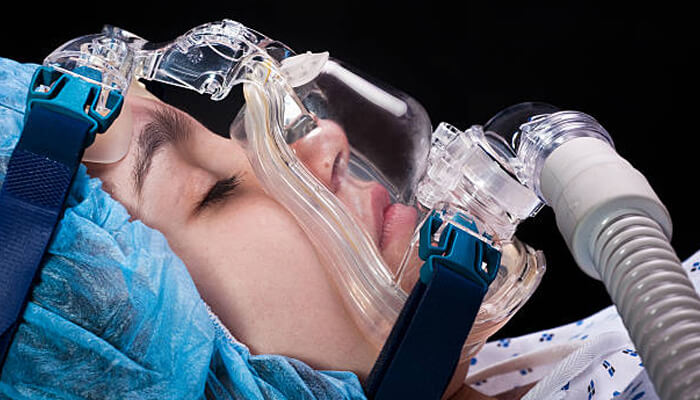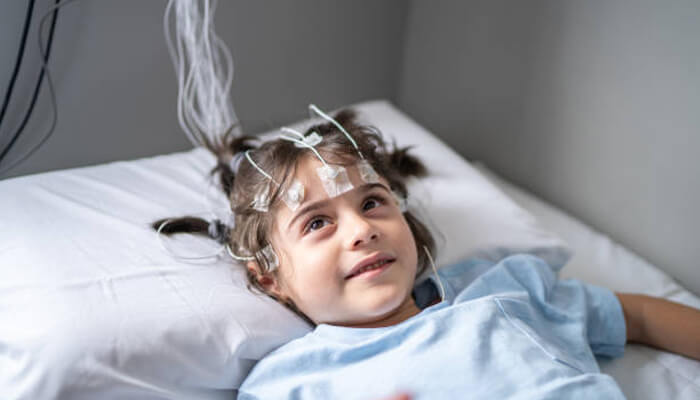Sleep Apnea is a sleep disorder characterized by repeated stops and starts during sleep, which occurs most commonly among children.
OSA (obstructive sleep apnea) occurs when airways become partially or completely blocked, causing breathing disruption, usually because throat muscles have relaxed too much or due to large tonsils and adenoids causing blockage of the airway.
Sleep apnea affects various aspects of children’s health. It can lead to fragmented restful slumber, oxygen desaturation, and sleep cycle disruption, ultimately having detrimental repercussions for overall well-being and happiness.
Sleep apnea can also impede memory consolidation and impair cognitive functioning, causing difficulties with learning, attention spans, and behavioral patterns.
Understanding the implications of sleep apnea on your child’s overall health helps you recognize its significance and can motivate them to take proper measures against it.
Signs and Symptoms of Sleep Apnea
Recognizing the signs and symptoms of sleep apnea in children is crucial for early diagnosis and intervention. Common indicators may include:
Snoring
Snoring occurs when the airway becomes blocked during sleep, causing soft tissues in the throat to vibrate, often loudly and disruptively. Snoring may be indicative of more serious sleep disorders like obstructive sleep apnea.
Restless Sleep
Children suffering from sleep apnea often toss and turn during sleep, often awakening multiple times throughout the night. Such restlessness makes getting an adequate night’s rest hard on these children as well as leading to daytime fatigue.
These breathing pauses, known as apneas, can last from seconds to several minutes and disrupt sleep significantly for children – leading them to wake frequently throughout the night.
Breathing Through the Mouth
Children who suffer from sleep apnea often breathe through their mouths instead of through their noses, leading to dry mouth and throat conditions and possibly other health complications like dental or ear infections.
EDS (Excessive Daytime Sleepiness)
Excessive daytime sleepiness is one of the hallmarks of sleep apnea in children, making them fatigued even after getting an adequate night’s rest. This makes kids sleepy during the day and may interfere with activities like school and playtime.
Behavior Issues
Sleep Apnea can often result in behavioral problems among children. Children affected may become irritable, aggressive, and hyperactive more easily than other children their age; additionally, they may struggle to pay attention and concentrate.
Poor Academic Performance
Sleep apnea can have serious repercussions on academic performance in children. Children suffering from untreated sleep apnea may struggle to focus in school and achieve lower grades than their counterparts.
If untreated, sleep apnea could even contribute to more severe health conditions like obesity, cardiovascular disease, or stroke – making the condition even harder to manage.
By knowing these signs and symptoms, as a parent, you can remain vigilant for issues in your child’s sleeping patterns and behaviors that might need further evaluation.
Risk Factors
Understanding the risk factors associated with pediatric sleep apnea can help you assess whether your child is at risk. Some common indicators may include:
Obesity
Excess weight can narrow airways and increase the chance of airway blockages during sleep.
Certain Medical Conditions
Children diagnosed with Down syndrome and craniofacial abnormalities such as cleft palate have an increased risk of obstructive sleep apnea.
Enlarged Tonsils and Adenoids
If these throat tissues become larger than usual, they can obstruct the airway during sleep and decrease airway capacity.
Family History
Sleep apnea tends to run in families; therefore, having someone in your immediate family who suffers from it increases your child’s risk.
Allergies and Nasal Congestion
Chronic nasal congestion due to allergies or upper respiratory infections can cause sleep apnea.
You can increase awareness of sleep apnea in children by discussing potential risk factors with a dentist and taking proactive steps to monitor sleep health.
Diagnosis
Explaining the process for diagnosing sleep apnea in children gives parents an understanding of how healthcare professionals assess and confirm this condition. Sleep studies, or polysomnographs, serve as primary diagnostic tools.
Sleep studies typically involve children staying overnight either in a laboratory or at home and using various sensors to record and measure different parameters during sleep, including brain activity, eye movements, heart rate, respiratory effort levels, and oxygen saturation levels.
This data helps pinpoint disruptions in breathing patterns such as apneas (pauses in breathing) as well as oxygen desaturation levels that could indicate potential issues with their respiratory systems or even cause them to snore loudly at night.
Sleep studies provide healthcare providers with invaluable insights into the severity and effects of sleep apnea on a child’s overall sleep quality and health and allow for accurate diagnoses as well as identification of an appropriate treatment approach.
By understanding the sleep study process – including placement of sensors, its non-invasive nature, and the presence of sleep technicians who will ensure comfort and safety for your child during a procedure, you can feel more at ease about seeking a diagnosis for your child.
Treatment Options
Common approaches might include:
Lifestyle Changes
As a parent, you should foster a conducive sleep environment and implement regular nightly bedtime rituals for your child. Weight management, where applicable, may play an integral part in lessening the severity of sleep apnea symptoms.
CPAP (Continuous Positive Airway Pressure) Therapy
Continuous Positive Airway Pressure therapy uses a machine that continuously provides air to an over-the-nose mask or both nose and mouth mask in order to keep the airway open during sleep, thereby avoiding apnea episodes.
The machine also boosts oxygen levels and ultimately leads to improved breathing during sleep. It has proven highly effective as a solution for moderate to severe sleep apnea cases.
Surgery
When sleep apnea in children is caused primarily by an enlargement of tonsils and adenoids, surgery (an adenotonsillectomy) may be indicated to ensure airway obstruction is resolved. Other interventions, including nasal surgery or jaw advancement procedures, may also help.
Each treatment option offers its own set of advantages and drawbacks; by exploring them with their healthcare provider, parents can have informed conversations regarding which one will best address your child’s individual circumstances.
Potential Complications
Highlighting potential complications that could emerge from untreated sleep apnea in children helps you understand its long-term impact and understand its long-term ramifications.
Chronic disruptions and oxygen desaturation may result in growth or developmental issues for your child, including:
Growth and Developmental Issues
Sleep apnea can interfere with the release of growth hormones during sleep, possibly hindering their release and altering how children grow physically and cognitively.
Behavioral Problems
Insufficient rest and disturbed sleeping architecture due to sleep apnea may contribute to behavioral issues like irritability, mood swings, aggression, hyperactivity, and poor impulse control – all hallmarks of behavioral disorders.
Cognitive Impairments
Sleep Apnea can impede cognitive performance, leading to difficulties with attention, concentration, memory, and learning – potentially impacting academic performance as a result.
Cardiovascular Problems
Sleep apnea can increase the risk of hypertension, cardiovascular disease, and abnormal heart rhythms in kids. Repeated drops in oxygen levels put excessive strain on the child’s cardiovascular system, which may have serious long-term implications.
Understanding these potential complications helps you understand why seeking evaluation and treatment for your child’s sleep apnea should be a priority.
Parental Role
As a parent, you can:
1. Engage with your child’s dental care provider regularly and communicate any observations regarding sleep, behavior, or any concerns regarding your child.
2. Keep a sleep diary to record your child’s sleeping patterns and any changes or behaviors over time. This can provide invaluable information during healthcare appointments as well as help identify patterns.
3. Create an optimal sleeping environment by developing a consistent bedtime routine and providing an inviting sleeping atmosphere (cool, dark, and quiet), along with minimizing distractions in the bedroom.
4. Encourage healthy lifestyle habits in kids like regular physical activity, eating well, and maintaining an appropriate weight.
5. Advocate for your child’s needs by actively taking part in treatment decision-making processes, asking the dentist questions, and seeking clarification when necessary.
By understanding your role in managing your child’s sleep apnea, the likelihood of successful treatment outcomes and enhanced quality of life increases for your child.
Follow-Up and Monitoring
It is critical that regular follow-up appointments and ongoing monitoring take place in order to assess treatment efficacy and address any remaining symptoms.
Regular consultations with a dentist allow them to adjust treatment plans as necessary, address concerns that arise, and track a child’s development over time.
Follow-up appointments may involve repeating sleep studies to measure treatment efficacy, monitor breathing patterns and oxygen levels closely, assess any changes to symptoms, as well as perform physical examinations, including tonsils/adenoids evaluation.
You must keep open communication with your child’s dentist, reporting any changes or concerns promptly. Furthermore, you should track sleep patterns and behaviors at home in order to provide this data during follow-up appointments.
Final Thoughts
With your newly gained knowledge and understanding, you are now equipped to play an active role in safeguarding the health and well-being of your child. Recognizing sleep apnea symptoms as soon as they appear is the first step toward improving their well-being.
A dental practitioner experienced in sleep apnea diagnosis and treatment can conduct a full evaluation of your child’s oral health and airway function. They can recommend a sleep study, which can provide valuable insights into the severity of your child’s sleep apnea symptoms.



